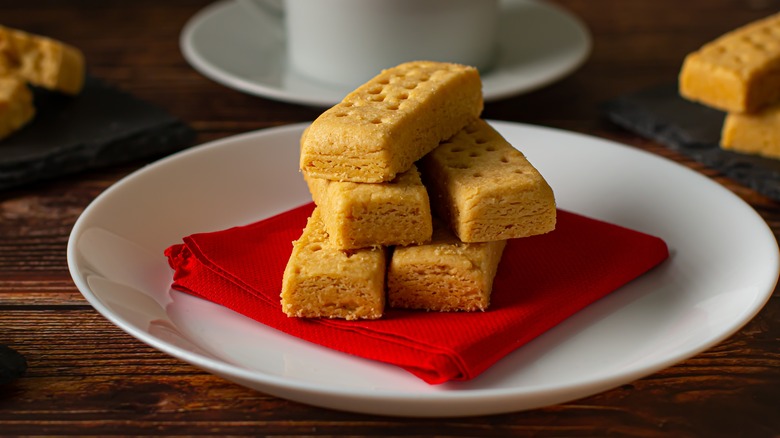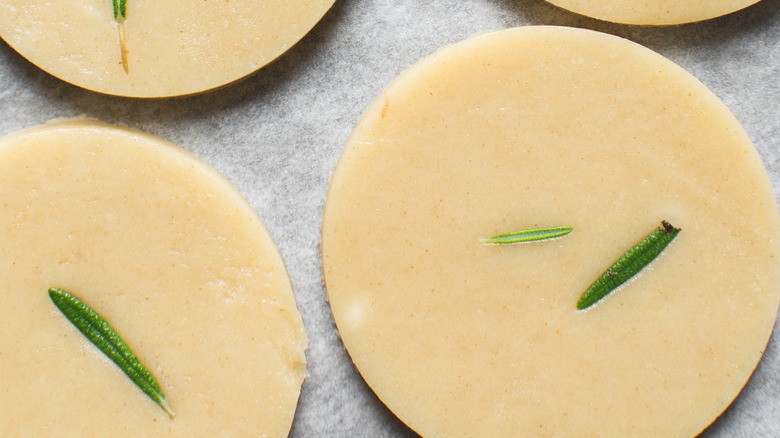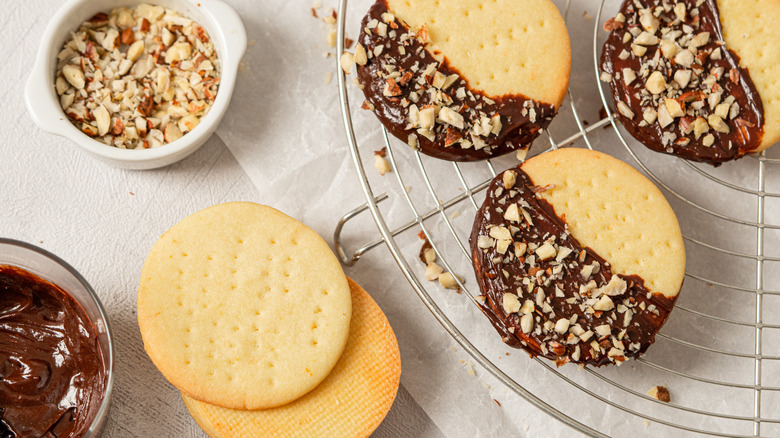What Sets Shortbread Apart From Other Cookie Doughs
Whether you're setting out to make a batch of homemade cookies or deciding which ones to grab from the store, it can be a little challenging to distinguish between all the different blonde, buttery cookies. When it comes to shortbread — and pretty much all other types of cookies — a basic recipe includes just butter, flour, sugar, and eggs. The differences have to do with the proportions of those ingredients.
The name "shortbread" actually gives a big hint as to what those measurements have to be. In the world of baking, "short" doughs have a high ratio of fat to flour. That fat coats the gluten, which keeps them from connecting and forming longer strands, so they stay short. In contrast, lots of gluten development creates a chewy texture, like in a great loaf of bread. Shortbread is a classic short dough, which yields a cookie that looks firm and crisp but is tender, crumbly, and melts in your mouth. Shortcrust pastry is common in pies and tarts.
Shortbread is a Scottish treat whose origins date back several thousand years. A classic recipe uses three parts flour, two parts butter, and one part sugar, and no eggs. Increase the flour and sugar and you get sturdier, but still super tender butter cookies. Tip the ratio in favor of even more flour plus add eggs, and you get a standard sugar cookie that is hefty enough to stand up to even the most enthusiastic decorators.
Tips for making great shortbread
It is especially important that you use the good stuff when making shortbread cookie dough. The taste of the sweetened butter and even the nuttiness of the flour will really shine through, so this is the time to splurge on high-quality ingredients.
To make perfect shortbread cookies, ensure that the butter is thoroughly softened — but not melted — so that it can be easily creamed with the sugar. The process of creaming butter that is fully soft — but does not yet have an oily sheen — creates a light-textured dough. Using overly softened or melted butter will result in a hard final cookie. Once well combined, incorporate the flour with as few strokes as possible, and don't work the dough too much to help prevent gluten development.
Because shortbread dough is on the delicate side and the butter will warm as you work, it's best to chill the dough until firm before baking. This makes it easier to handle and also stops the dough from spreading while in the oven. Many recipes call for simply pressing the dough into an ungreased pan and then cutting them while they are still warm, which yields clean, uniform edges. Other versions are cut into small, rectangular planks before baking. Some bakers will cut out shapes from the dough, but it's best to use simple cutters since the dough is delicate. A round in the freezer after cutting can help them keep their shape.
How to jazz up classic shortbread
If you want to add different flavorings to your shortbread cookies, stick to ingredients that will not introduce moisture to the dough. Finely ground dried teas, toasted nuts, dried edible flowers, herbs, or citrus zest would all be lovely additions. Try combining lavender with lemon zest or a little black tea with warm spices like cinnamon, clove, and cardamom. Shortbread can also go savory with olive oil in the dough and spices like cumin, coriander, black pepper, or dried chilies. Pepitas, sesame seeds, and walnuts would also be great. If you really want to get creative, try making Indian green chile and cheddar shortbread cookies.
If you are new to shortbread and worried about complicating the dough, try dipping the cookies instead. Once baked and cooled, a chocolate dip is a great way to add pizzazz without affecting how the cookies will cook. Try dipping them in dark chocolate and adding a sprinkle of flaky sea salt, or dip the cookies in white chocolate and then coat them in freeze-dried raspberry powder.



